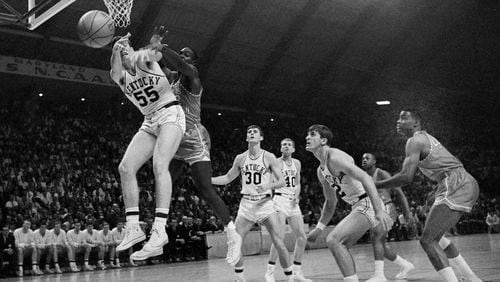Fifty years ago Saturday, Larry Conley played in what would become the most socially significant college basketball game ever. Conley’s top-ranked Kentucky team, composed entirely of white players, was upset by Texas Western (now known as Texas-El Paso), which started five African-Americans, for the NCAA championship.
The 1966 final has been hailed as the sports equivalent of Brown vs. Board of Education. Books have been written. The movie “Glory Road” was made. (Conley was a paid consultant, though he did no real consulting.) The Texas Western team is enshrined in the Naismith Hall of Fame. Open the NCAA March Madness app and you’ll find Texas Western-Kentucky available for viewing under “Classic Games,” even if the game itself — the Miners led for the final 30 minutes, winning 72-65 — was no stem-winder.
As the game’s golden anniversary approached, someone called Conley and asked how it felt to have been on the wrong side of history. Conley’s response: “I would rather have not been a part of history at all. I would rather have won the game.”
Then this: “I give credit to the other side. They played better than we did that night.”
And what about the racial aspect? Was the game fraught with tension? “No,” said Conley, who’s 72 and who has lived in Dunwoody since 1980. “It was never a part of what we thought about in the game. I still contend that what has perpetuated this game is its importance in the media.”
Then: “We didn’t think a thing about (race). It was just another game. People look at us (now) like we had never played against a black player in our lives. That part was not important to us as players. I can’t speak for Texas Western; I can speak for us. We were trying to win a national championship.”
Maybe this sounds like an oblivious white guy dealing in denial. It shouldn’t. Conley knows as much about college basketball as anyone living, having done TV commentary for more than 1,800 games. Asked to name the networks for which he has worked, he said: “All of them.”
Fact: Black players had been a major part of college basketball long before March 19, 1966. Of the NCAA tournament’s previous 11 most outstanding players, six were African-American. In 1962, Cincinnati won a second consecutive championship with four black starters. In 1963, Loyola (Ill.) upset the Bearcats in the title game; the Ramblers likewise had four black starters.
So why did Texas Western winning resonate in a way that Cincinnati and Loyola winning did not? Because the Miners had one more black starter? Or because their opponent was Kentucky?
Conley: “I wonder if the focus about an all-white team would have been as strong if we’d lost (in the semifinals) to Duke, which was also an all-white team. Maybe the focus was on coach Rupp, maybe because of his age.”
Adolph Rupp had won four NCAA titles at Kentucky. As of 1966, no African-American had played basketball at an SEC school. Perry Wallace would be the first, making his varsity debut for Vanderbilt in 1967. In 1959, 1961 and 1962, Mississippi State declined three NCAA tournament bids because it didn’t want its teams competing against black athletes. (In March 1963, the Bulldogs defied the Mississippi legislature and sneaked across the state line to face Loyola.)
As his sport’s most famous figure and steward of the SEC’s northernmost program, Rupp might have pushed to break the barrier. Conventional wisdom held that “The Baron,” as the imperious man was known, really didn’t want black players. Conley disputes that, saying he drove to Louisville on his coach’s behalf to lobby the state’s No. 1 high schooler. He says Wes Unseld told him, “I just don’t want to go to Kentucky.”
A photo of the 1964 Kentucky state high school all-tournament team shows 10 players, six of them black. Four would play on championship teams in the NBA or ABA. None would play for the Wildcats. The photo was taken in UK's Memorial Coliseum. Rupp's office was roughly 25 yards away. Not until 1969 did an African-American — the 7-footer Tom Payne of Louisville Shawnee — sign to play basketball at Kentucky.
As Conley suggested, black opponents weren’t new to the Wildcats. He’d grown up in Ashland, Ky., and played against African-Americans throughout high school. A week before facing Texas Western, Kentucky beat Michigan and Cazzie Russell, the national player of the year, in the Mideast final. What happened that night in College Park, Md., wasn’t because of culture shock.
Kentucky started slowly against Texas Western but led 9-5. The game turned when Bobby Joe Hill stole the ball from Tommy Kron at midcourt, then from Louie Dampier. Hill’s back-to-back breakaways put the Miners ahead 14-9. (Conley: “I had my back turned. I didn’t see either one. I asked Tommy, ‘What the hell’s going on?’ ”)
The Wildcats cut the lead to a point several times in the second half. Finally they broke. Texas Western was the better team that night and might have been most nights. (The Miners entered the NCAA tournament ranked No. 3, trailing only Kentucky and Duke. This was an upset, but it wasn’t N.C. State over Phi Slama Jama.)
Watching it now, the game doesn’t appear an Armageddon. There’s no evidence of trash-talking. (Olden days, folks.) Kentucky sub Cliff Berger and Texas Western’s Nevil Shed get miffed when vying for a loose ball, but nothing comes of it. Late in the game, Pat Riley — who missed 15 of 22 shots — fouls Hill and then shakes the little guard’s hand.
Over the intervening five decades, all manner of incendiary stories have arisen, some involving Rupp’s alleged use of racial slurs to describe the Miners. (After retirement, Rupp did tell a Louisville newspaper that Texas Western was “a bunch of crooks.”) Conley insists he never heard Rupp deploy such slurs: “I’m not going to say it didn’t happen. I’m saying I never heard it.”
And yet: At Kentucky’s award banquets, the sports editor of the Lexington Herald told the crowd: “At least we’re the No. 1 white team in the country.” Apparently someone was cognizant of demographics.
Rupp wouldn’t win another title. In 1971 his Wildcats (with Payne) were beaten 107-83 in the NCAA regional semis by Western Kentucky, a team with five homegrown black starters. His final game was a 1972 NCAA loss to Florida State, coached by Hugh Durham and led by Ron King and Otto Petty, two black players from Louisville Central. Rupp died in 1977.
Conley’s memories of his senior season are bittersweet. The team known as “Rupp’s Runts” — the tallest starter was 6-foot-5; the 6-4 Riley jumped center — remains one of the school’s most beloved. To the world beyond the Bluegrass, the 27-2 Runts are known as Texas Western’s foils.
Conley scored 10 points, just off his average, against the Miners. He fouled out with three minutes remaining. He’d had the flu that week and received five penicillin shots. Frank Deford’s account in the March 28, 1966, issue of Sports Illustrated makes much of Conley’s illness. It does not mention the racial component of either team.
Fifty year later, Conley concedes that the game “has morphed into something else.” That doesn’t mean he feels better about it. “If there are a lot of black people who use that game as motivation to better their lives, I say bravo. Would I rather have won the game? You bet your ass.”
About the Author







